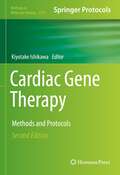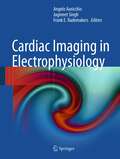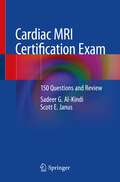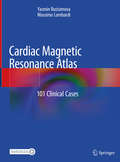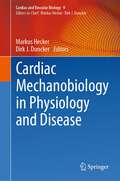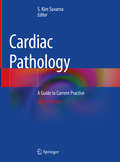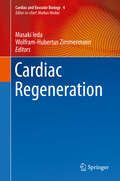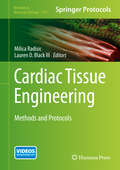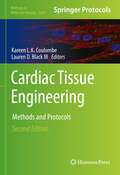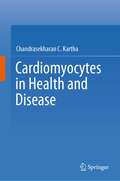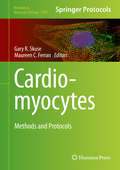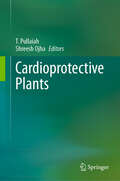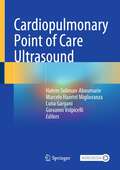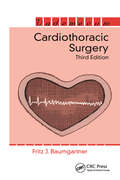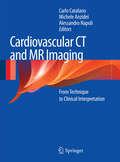- Table View
- List View
Cardiac Gene Therapy: Methods and Protocols (Methods in Molecular Biology #2573)
by Kiyotake IshikawaThis second edition volume expands on the previous edition with updated techniques and discussions on topics such as gene suppression, editing, and reprogramming; cardiac gene therapy vectors and promoters; cardiac gene delivery methods; pulmonary hypertension; and patient screening and measuring the efficacy of cardiac gene therapy. Written in the highly successful Methods in Molecular Biology series format, chapters include introductions to their respective topics, lists of the necessary materials and reagents, step-by-step, readily reproducible laboratory protocols, and tips on troubleshooting and avoiding known pitfalls. Cutting-edge and comprehensive, Cardiac Gene Therapy: Methods and Protocols, Second Edition is a valuable tool for researchers in cardiology who are conducting gene therapy research. This book will lead to further advancements and successful clinical translations in the field.
Cardiac Imaging in Electrophysiology
by Frank E. Rademakers Jagmeet Singh Angelo AuricchioCardiac arrhythmias are a major cause of death (7 million cases annually worldwide; 400,000 in the U.S. alone) and disability. Yet, a noninvasive imaging modality to identify patients at risk, provide accurate diagnosis and guide therapy is not yet available in clinical practice. Nevertheless, there are various applications of electrophysiologic imaging in humans from ECG/CT reconstructions, MRI to tissue Doppler investigations that provide supplimentary diagnostic data to the cardiologist. EP laboratories are experiencing an increase in volume, for both diagnostic and interventional electrophysiology studies, including mapping, ablation, and pacemaker implants. The equipment requirements for these procedures are stringent, include positioning capabilities, and dose management. This book is designed to review all of the current imaging methodologies that assist in diagnosis within the electrophysiology department.
Cardiac MRI Certification Exam: 150 Questions and Review
by Scott E. Janus Sadeer G. Al-KindiThis book serves as a board review book for cardiovascular magnetic resonance imaging (CMR). CMR is now an essential part of cardiology training and there is yet to be a dedicated review book for the topic. This book seeks to fill that gap. With 150 questions and answers, this review provides a comprehensive and easily readable educational tool for trainees and cardiologists. The book is divided into 10 chapters, each about 15 questions. The multiple-choice questions cover topics according to the board examinations blueprints, including a wide spectrum of cardiac pathologies and concepts. Answers are supported by concise summaries and explanations to aid understanding. Each question also includes links to the latest resources and literature. This book helps readers not only prepare for CMR boards, but provides a good review of anatomy and pathology for cardiac imagers.
Cardiac Magnetic Resonance Atlas: 101 Clinical Cases
by Yasmin Rustamova Massimo LombardiThis book presents the main cardiac pathologies, providing a helpful guide featuring clinical cases and electronic supplementary material. There are several systematic books on cardiac magnetic resonance, which approach the different pathologies and related pathophysiology in a general manner, and these are useful for readers at an early stage in their medical careers. However, when it comes to individual patients (during the acquisition of images and reporting activities) there is no book providing operative protocols or systematic descriptions of details to look for. In the eight chapters (Cardiomyopathies, Myocarditis, Ischemic Heart Disease, Valvular Heart Diseases, Cardiac Masses, Pericardial Diseases, Congenital Heart Disease, and Miscellanea), the individual pathology is illustrated with a clinical case.The cases are divided into four sections: An introduction with a short medical history and the purpose of the diagnostic CMRA detailed CMR acquisition protocolCMR images, indicating purpose, method, analysis and meaning of the image, as well as videos.Concluding paragraph with the final diagnosis reached on the basis of the findings obtained in each image This book, collecting one hundred one clinical cases covering a broad spectrum of cardiac diseases, is an invaluable tool for radiologists and cardiologists.
Cardiac Mechanobiology in Physiology and Disease (Cardiac and Vascular Biology #9)
by Markus Hecker Dirk J. DunckerThis book presents the latest findings in the field of cardiac mechanobiology in health and disease.Cardiac mechanobiology provides knowledge of all aspects of mechanobiology of the heart. Cardiomyogenesis is discussed as well as the mechanobiology of cardiac remodeling and regeneration. The molecular mechanisms of mechanoperception and mechanotransduction in cardiomyocytes are explained, as well as stretch induced differentiation of cardiomyocytes derived from induced pluripotent stem cells. This volume of the series Cardiac and Vascular Biology complements the volume Vascular Mechanobiology in Physiology and Disease (volume 8) published in this series. The book is aimed at clinicians as well as researchers in cardiovascular biology, bioengineering and biophysics, and also represents an educational resource for young researchers and students in these fields.
Cardiac Pathology: A Guide to Current Practice
by S. Kim SuvarnaThis updated second edition provides a comprehensive overview of cardiac pathology. Clear illustrations of the common styles of dissection are provided along with the normal anatomy and histology. The chapters cover autopsy heart examination, ischemic heart disease, myocarditis, sudden death, valvular disease, transplant pathology, cardiomyopathy, cardiac neoplasia and congenital heart disease with a clear analysis of diagnostic criteria (macroscopic, microscopic and genetic) for both common cardiac diseases and those of less common types. The text is accompanied by high quality macroscopic and microscopic images and references to other specialty data sources. Cardiac Pathology: A Guide to Current Practice is aimed at established pathologists and trainees, as well as any clinician with an interest in cardiac disease. It will be of value to those working in cardiac surgery, cardiology and those in the autopsy/forensic fields.
Cardiac Pathology: A Guide to Current Practice
by Simon SuvarnaCardiac disorders are an exciting area of classic pathology and recently defined disease. Cardiac Pathology: A Guide to Current Practice discusses the various disorders and also provides a backdrop of developmental embryology, diagnostic imaging and current therapeutics. Cardiac Pathology: A Guide to Current Practice aims to deliver in bench-book format a comprehensive overview of cardiac pathology that is relevant to those practicing in surgical pathology and autopsy arenas. Clear illustrations of the common styles of dissection are provided along with the normal anatomy and histology. Chapters cover the approach to the autopsy heart, ischemic heart disease, myocarditis, sudden death, valvular disease, transplant pathology, cardiomyopathy, cardiac neoplasia and congenital heart disease with a clear analysis of diagnostic criteria (macroscopic, microscopic and genetic) for both common cardiac diseases and those of rare format. The text is accompanied by high-quality macroscopic and microscopic images and references to other in-depth specialty data sources. Although aimed in particular at pathologists, Cardiac Pathology: A Guide to Current Practice should also be of value to cardiologists, cardiothoracic surgeons and other professions allied to medicine.
Cardiac Regeneration (Cardiac and Vascular Biology #4)
by Masaki Ieda Wolfram-Hubertus ZimmermannThis Volume of the series Cardiac and Vascular Biology offers a comprehensive and exciting, state-of-the-art work on the current options and potentials of cardiac regeneration and repair. Several techniques and approaches have been developed for heart failure repair: direct injection of cells, programming of scar tissue into functional myocardium, and tissue-engineered heart muscle support. The book introduces the rationale for these different approaches in cell-based heart regeneration and discusses the most important considerations for clinical translation. Expert authors discuss when, why, and how heart muscle can be salvaged. The book represents a valuable resource for stem cell researchers, cardiologists, bioengineers, and biomedical scientists studying cardiac function and regeneration.
Cardiac Regeneration: Methods and Protocols (Methods in Molecular Biology #2158)
by Kenneth D. Poss Bernhard KühnThis detailed book addresses major goals of regenerative medicine and the cardiovascular research community with techniques to replenish lost cardiomyocytes, avoid scar-associated pathology, and improve myocardial infarction (MI) outcomes. The collection begins with a section on cardiac injury models, including zebrafish, neonatal and adult mice, and pigs, and continues with sections covering culturing cardiomyocytes from different species as well as methods for labeling or manipulation of cardiac tissue for the purpose of answering questions in regeneration. Written for the highly successful Methods in Molecular Biology series, chapters include introductions to their respective topics, lists of the necessary materials and reagents, step-by-step, readily reproducible laboratory protocols, and tips on troubleshooting and avoiding known pitfalls. Authoritative and practical, Cardiac Regeneration: Methods and Protocols provides the latest models and methods used in the field of heart regeneration, designed for researchers interested in establishing these assays in their laboratories to reproduce or extend findings, and for familiarizing themselves with the field if it is new to them.
Cardiac Remodeling: Molecular Mechanisms (Advances in Biochemistry in Health and Disease #5)
by Naranjan S. Dhalla Bodh I. JugduttThe main objective of Cardiac Remodeling: Molecular Mechanisms is to summarize the major research advances in molecular, biochemical and translational aspects of cardiac remodeling over the last 2 to 3 decades under one cover and touch on future directions. It provides a high profile and valuable publication resource on molecular mechanisms of cardiac remodeling for both the present and future generations of researchers, teachers, students and trainees. This book should stimulate future translational research targeted towards discovery and development for preventing, limiting and reversing bad remodeling over the next few decades, with the ultimate goal of preventing progression to systolic and/or diastolic heart failure. The chapters suggest potential novel strategies that should receive attention for translating basic research knowledge to application in patients at the bedside.
Cardiac Tissue Engineering: Methods and Protocols (Methods in Molecular Biology #1181)
by Milica Radisic Lauren D. Black IIICardiac Tissue Engineering: Methods and Protocols presents a collection of protocols on cardiac tissue engineering from pioneering and leading researchers around the globe. These include methods and protocols for cell preparation, biomaterial preparation, cell seeding, and cultivation in various systems. Written in the highly successful Methods in Molecular Biology series format, chapters include introductions to their respective topics, lists of the necessary materials and reagents, step-by-step, readily reproducible laboratory protocols, and key tips on troubleshooting and avoiding known pitfalls. Authoritative and practical, Cardiac Tissue Engineering: Methods and Protocols highlights the major techniques, both experimental and computational, for the study of cardiovascular tissue engineering.
Cardiac Tissue Engineering: Methods and Protocols (Methods in Molecular Biology #2485)
by Lauren D. Black III Kareen L. K. CoulombeThis detailed volume presents an updated collection of state-of-the-art protocols in cardiac tissue engineering. These protocols demonstrate advancements in cell sourcing, assembly, and use of engineered cardiac tissues, imaging and diagnostics, as well as therapeutic applications. New animal models, biomaterials, and quantitative analyses are described for broad adoption. Written for the highly successful Methods in Molecular Biology series, chapters include introductions to their respective topics, lists of the necessary materials and reagents, step-by-step, readily reproducible laboratory protocols, and tips on troubleshooting and avoiding known pitfalls. Authoritative and practical, Cardiac Tissue Engineering: Methods and Protocols, Second Edition serves as an ideal resource for inspiring the advancement of cardiotoxicity assessment, drug discovery, and heart repair and regeneration in order to accelerate heart health improvement around the globe.
Cardio-Respiratory Control in Vertebrates: Comparative and Evolutionary Aspects
by Mogens L. Glass Stephen C. WoodThe focus of this book is the evolution of cardiovascular and respiratory control in vertebrates. Life originated in water, which has constantly changing temperatures and O2 levels. Fish gills can extract up to 80% of their inspired O2, because they have a countercurrent bloodstream. Oxygen sensors have been found within the gill arches of ray-finned fish such as carp and trout, and these O2 sensors screen the inspired water and the capillary blood. Very likely, land vertebrates and the lungfish arose as a sister group, and both possess real lungs. Lungfish include 6 species, inhabiting shallow lakes or rivers, whereas the second ramification includes all the land vertebrates. A possible ancestor to the lungfish and land vertebrates has been discovered in China, and this fossil (Styloichthys) bridges a gap. Living 417 million years ago, it could represent one of the last ramifications before the common ancestor to the lungfish and land vertebrates. In addition, rather constant atmospheric O2 levels permit a joint acid-base regulation by the lung and the kidney. Likewise, lungfish and land vertebrates share a central control of pulmonary ventilation, while the peripheral receptor contribution to acid-base regulation is minor.
Cardiology Procedures: A Clinical Primer
by Robert C. Hendel Carey KimmelstielThis extensively revised edition is a single compact reference that describes a wide variety of diagnostic and therapeutic procedures performed by cardiologists. The focus is on the clinical application of these procedures with descriptions of their technical aspects, as well as contraindications and potential complications. The book provides detailed instruction on the interpretation of clinical data generated during these procedures and includes case presentations to illustrate how they are utilized in clinical practice.Cardiology Procedures: A Clinical Primer contains distilled clinical information and data important to those involved in the clinical care of cardiac patients. Comprising practical material designed to help in learning the diagnostic and therapeutic cardiology procedures performed in clinical practice, it will also be useful for trainees and practitioners in related disciplines.
Cardiology Science and Technology
by Dhanjoo N. GhistaCardiology Science and Technology comprehensively deals with the science and biomedical engineering formulations of cardiology. As a textbook, it addresses the teaching, research, and clinical aspects of cardiovascular medical engineering and computational cardiology. The books consists of two sections. The first section deals with left ventricular
Cardiomyocytes in Health and Disease
by Chandrasekharan C. KarthaThis book is a treatise on cardiomyocytes, the most important cell for the contractile function of the heart. There has been significant progress in our understanding of the function-related structure, developmental processes and their determinants, mechanisms of cell cycle regulation, post-natal growth, energy metabolism, and reversible and irreversible response of cardiomyocytes to diverse forms of physiological stress and injury. There is also more clarity on the alterations in the biological mechanisms in cardiomyocytes that lead to pathological states and the changes in the cells that occur secondary to disease conditions. Thanks to these advances in knowledge, there have been great gains in attempts to identify disease biomarkers and therapeutic targets for better management of patients with heart diseases. Possibilities to induce regeneration or proliferation of cardiomyocytes and thus repair and or regenerate the damaged heart are also on the horizon.
Cardiomyocytes: Methods and Protocols (Methods in Molecular Biology #1299)
by Gary R. Skuse Maureen C. FerranThis volume has been assembled for scientists interested in basic and applied biomedical research directed toward understanding the development, genetics and function of cardiomyocytes. The methods and protocols contained within it address cell culture techniques, cardiomyocyte differentiation and redifferentiation, experimental induction of cardiomyopathies, introducing genes into cardiomyocytes, genomic approaches to the understanding cardiomyocytes, cryopreservation of neonatal cardiomyocytes and modeling of cardiomyocyte function. Written in the highly successful Methods in Molecular Biology series format, chapters include introductions to their respective topics, lists of the necessary materials and reagents, step-by-step, readily reproducible laboratory protocols and tips on troubleshooting and avoiding known pitfalls. Practical and current, Cardiomyocytes: Methods and Protocols explores complimentary areas of cardiomyocyte science that, taken together, can inform individuals with a broad range of interests.
Cardiomyocytes: Methods and Protocols (Methods in Molecular Biology #2894)
by Dhananjie N. K. Chandrasekera Rajesh KatareThis detailed volume collects diverse experimental approaches essential for researchers exploring the intricacies of cardiomyocyte biology and pathology. The book features basic isolation methods, techniques for studying specific cellular processes and responses, protocols that bridge in vitro studies with in vivo models, all of which are vital for delving into the complexities of cardiomyocyte biology and its implications for cardiovascular health and disease. Written for the highly successful Methods in Molecular Biology series, chapters include introductions to their respective topics, lists of the necessary materials and reagents, step-by-step and readily reproducible laboratory protocols, and tips on troubleshooting and avoiding known pitfalls. Authoritative and practical, Cardiomyocytes: Methods and Protocols serves as a valuable resource for both novice and seasoned researchers in the field of cardiomyocyte research.
Cardioprotection Against Acute Myocardial Infarction
by Shinya MinatoguchiThis book will provide readers with a detailed understanding of the ischemic damage to the myocardium after myocardial infarction, as well as essential tools for the treatment of damaged heart after myocardial infarction. It discusses various methods such as pharmacological pre- and post-conditioning, cytokine therapy, and cell therapy especially using Muse cells.The coverage of Muse cell therapy, which includes the latest work done by the author and his collaborators, is a unique feature of the book. Muse cells have self-renewability and have ability to differentiate into cells with the characteristics of all three germ layers from a single cell, while they are non-tumorigenic. It is the first book to feature the Muse cell therapy, which may offer the new promising therapeutic strategy for acute myocardial infarction.
Cardioprotective Plants
by T. Pullaiah Shreesh OjhaThis book provides a comprehensive overview of plants and plant-derived phytochemicals in the management of cardiovascular diseases. It presents the cardioprotective potential of plants and phytochemicals, covering various preclinical models, assays, and clinical research protocols of plant medicine for cardioprotection. Chapters cover the role of plants and phytochemicals in prevention and cure of atherosclerosis, hypertension, cardiomyopathy, arrhythmia, myocardial ischemia, cardiotoxicity and the underlying pharmacological, molecular, biochemical, and immunobiological mechanisms. The book also includes toxicological aspects (safety evaluations), meta-analysis of clinical trials, critical assessments, drawbacks and challenges for adopting phytomedical approaches in evidence-based medicine for the treatment of CVDs. Screening methods and plant foods for cardioprotection are also covered. The book will be a reference for all researchers working on the role of plant-based products on cardiovascular systems and on cardioprotective agents of plant origin. It will be useful for students, researchers, physicians, nurses, industrial scientists, nutritionists, pharmacists, pharmacologists, toxicologists, botanists, and traditional medicine practitioners. In particular, researchers working on heart problems, diseases, toxicity, physicians treating patients with heart problems, hospitals, pharmacy institutions, pharmacy students and researchers, ethnobotanists, and people working in traditional medicine will find this book useful.
Cardiopulmonary Point of Care Ultrasound
by Hatem Soliman-Aboumarie Marcelo Haertel Miglioranza Luna Gargani Giovanni VolpicelliThis book is an illustration-rich practically focused resource on the use of cardiopulmonary point of care ultrasound (POCUS). It focuses on the applications of POCUS in a wide range of medical specialties especially critical care medicine, cardiology, emergency and respiratory medicine. Topics covered include the application of POCUS in diagnostics, monitoring of various cardiorespiratory conditions such as pulmonary edema, and the role it can perform in guiding interventions for pleural and pericardial effusion. Stunning illustrations and instructive accompanying video clips ensure that the reader can develop a deep understanding of how to properly apply the technology into day-to-day clinical practice. Cardiopulmonary Point of Care Ultrasound is edited and authored by a group of world-renowned experts in the field of critical care echocardiography and POCUS from critical care medicine, cardiology, respiratory medicine, emergency medicine, surgery, radiology and cardiac physiology with a powerful multi-specialty and multi-disciplinary collaboration. It offers detailed insight into the applications of this technique and associated technologies across medical specialties with a focus on cardiorespiratory disorders. The user-focused emphasis in this resource makes it an ideal bedside manual for both experienced practitioners and trainees in these fields.
Cardiothoracic Surgery
by Fritz BaumgartnerThis handbook is a manual intended for residents at any stage of their experience, including cardiothoracic fellowship. It is meant as a guideline to understand the pathophysiologic rationale of action in the operating room and intensive care unit. Emphasis is placed on physiology, anatomy, pathology, medical management, and surgical technique.
Cardiovascular Applications of Stem Cells
by Khawaja H. HaiderThe book covers multifarious aspects of stem cell-based therapy for cardiovascular diseases. In addition to stem cells from different sources for cell-based therapy, it covers stem cell organoids and stem cell-derived exosomes in regenerative medicine. The book also encompasses advances in state-of-the-art infrastructure to improve the maturation aspects of pluripotent stem cells-derived cardiomyocytes using a novel scaffold-based cell culture system for cell delivery in experimental animal models and clinical settings. Besides the use of mesenchymal stem cells, the book includes chapters on the use of cardiac progenitor cells (CPCs), microtissue implantation, use of PSCs for valvulopathies, application of de-cellularized organ arrays as natural scaffolds for cardiac tissue engineering, use of epicardial stem cells, and skeletal myoblasts in cell-based therapy for myocardial regeneration. Besides the cell-based therapy approach, the book also reviews the stem cell-derived exosomes, their characteristics, and engineering strategies to enhance their therapeutic potential via targeting and drug loading and use in disease models. Additionally, the book also discusses the latest research on injectable hydrogels for cardiovascular regeneration and how hydrogel-based delivery protects the cells and their retention post-engraftment in the heart, a problem, which significantly reduces the efficacy of cell-based therapy.
Cardiovascular CT and MR Imaging: From Technique to Clinical Interpretation
by Carlo Catalano Alessandro Napoli Michele AnzideiThe availability and diffusion of high-performance technologies has strengthened the role of CT angiography and MR angiography as simple and reliable techniques for the characterization and treatment planning of the main diseases of the cardiocirculatory system, an understanding of which has become essential for all radiologists. The aim of this book is to provide technical indications which are both concise and thorough regarding the main methods and examination techniques for performing high-quality CT angiography and MR angiography studies in a broad range of clinical settings. This is supported by a large number of cases and is rich with advice on image interpretation and practical suggestions for the evaluation and reporting of the examinations. The text will therefore also aim to provide a comparison of the advantages and limitations of the two techniques in various diseases and vascular regions, thus offering indications to both the expert and trainee radiologist.
Cardiovascular Calcification
by Michael HeneinThe book systematically describes the clinical and scientific aspects of cardiovascular calcification. Chapters detail the mechanisms associated with arterial and valve calcification, relevant risk factors, pathophysiology and the latest therapeutic techniques. Recent diagnostic technological developments including how computed tomography (CT) scanning can be utilized along with Agatston score to quantify coronary arterial calcification when investigating whether a patient for sub-clinical atherosclerosis are covered. The correlation with the presence of arterial calcification and extent of coronary stenosis is also explored. Cardiovasular Calcification details relevant aspects of the basic science and reviews the latest pathological and therapeutic techniques used in treating patients with cardiovascular calcification. It is therefore an essential resource for practicing cardiologists, cardiac surgeons, vascular specialists and radiologists.
